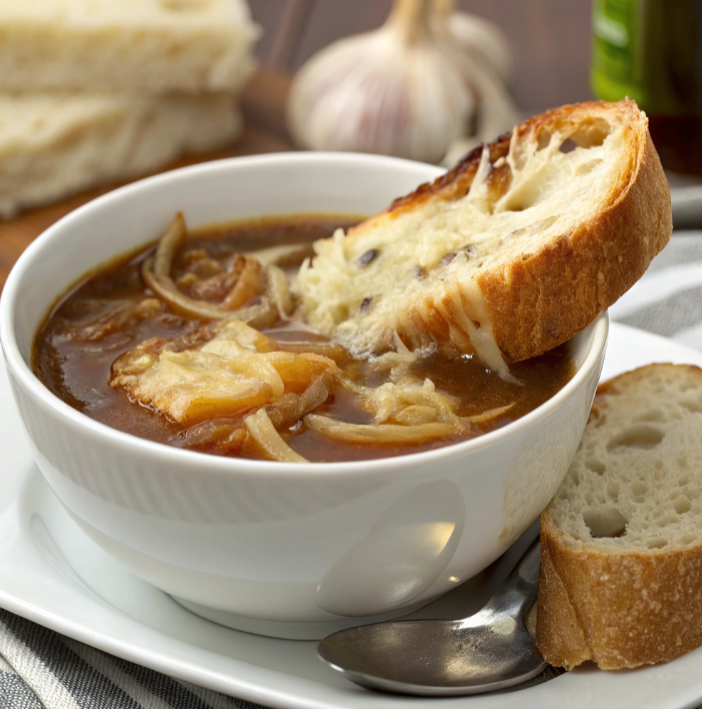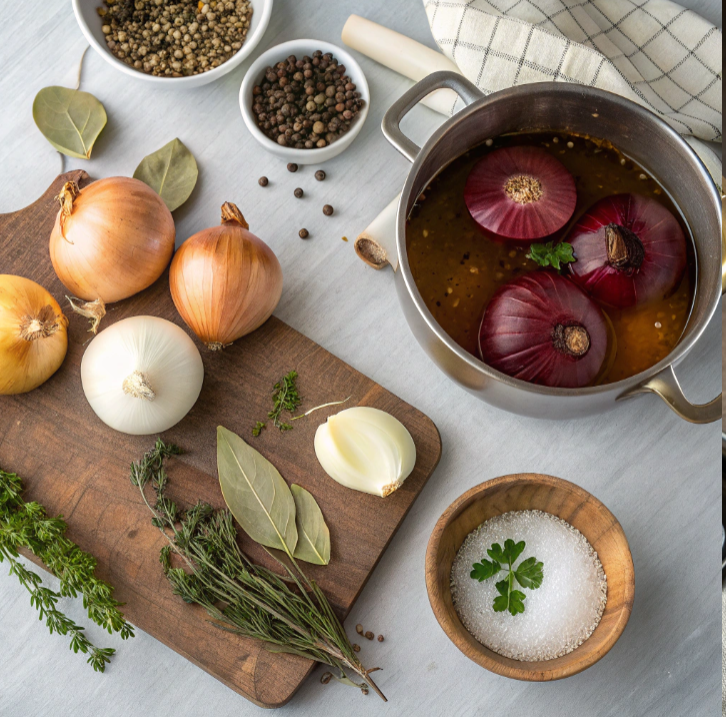 The onion boil soup
The onion boil soup
The onion boil has long been a cherished cooking technique in kitchens worldwide, valued for its ability to unlock rich flavors and promote health. As a versatile culinary method, it transforms onions into a tender, sweet ingredient perfect for enhancing soups, stews, and standalone dishes. Whether you’re a beginner or a seasoned chef, understanding the onion boil can open up exciting possibilities for your meals. This article will take a deep dive into everything you need to know about this method, from its basic principles to its role in a balanced diet.
Understanding the Basics of Onion Boil
The onion boil is a simple yet effective process. It involves simmering onions in water until they reach the desired level of tenderness and flavor. This technique works by releasing the natural sugars in the onions, creating a subtle sweetness that complements a variety of dishes.
When performing an onion boil, start by choosing fresh onions. Peel the outer layers, and decide whether to slice or leave them whole depending on your recipe. Bring water to a gentle boil before adding the onions, ensuring an even cook. This method is not only straightforward but also adaptable, allowing for creative variations with herbs, spices, and other vegetables.
Nutritional Perks of Boiling Onions
Incorporating an onion boil into your meals can significantly boost your health. Onions are packed with nutrients, including vitamin C, vitamin B6, and manganese, all of which contribute to immune function and overall wellness.
This culinary technique is particularly effective at preserving these nutrients, making it a healthier alternative to frying or roasting. Additionally, the process retains antioxidants such as quercetin, which has been linked to reduced inflammation and better heart health. Drinking the onion-infused broth after boiling can further enhance digestion and support hydration. By embracing this method, you’re not just elevating the flavor of your meals but also enriching their nutritional value.
Different Types of Onions for Boiling
Choosing the right onion can make a significant difference in your onion boil. Each type of onion offers unique flavors and textures, making it essential to select the one that best suits your dish.
- Yellow onions: These are the most common choice, offering a balanced sweetness and sharpness.
- Red onions: Known for their vibrant color and mild flavor, they work well in broths and light soups.
- White onions: These onions have a crisp texture and are ideal for boiling in spicy or tangy recipes.
- Sweet onions: Varieties like Vidalia are perfect for dishes requiring a more pronounced sweetness.
- Shallots: Though smaller, they bring a delicate, nuanced flavor to an onion boil.
Experimenting with these types can help you discover new ways to enhance your recipes.
Step-by-Step Guide to Preparing an Onion Boil
Follow these steps to master Boiling onions
- Select your onions: Choose fresh, firm onions free of blemishes.
- Prepare the onions: Peel and wash them thoroughly. Slice them if needed.
- Boil water: Use a pot large enough to submerge the onions completely.
- Add onions to the pot: Place the onions in boiling water, ensuring they are evenly spaced.
- Simmer gently: Reduce heat and let the onions cook for 15-30 minutes, depending on their size.
- Season as desired: Add salt, pepper, or herbs during the final stages of boiling.
- Drain and serve: Remove the onions carefully and use them in your dish or as a side.
Consistency is key to achieving a perfectly tender result every time.
Ingredients for a Basic Onion Boil
To prepare a flavorful onion boil, you’ll need the following simple ingredients:

Ingredients for the onion soup
- Onions: 2–4 medium-sized onions (yellow, red, white, or sweet, depending on your preference).
- Water: Enough to fully submerge the onions in your pot (approximately 6–8 cups).
- Salt: 1 teaspoon, or to taste.
- Peppercorns: 5–7 whole peppercorns for subtle spice (optional).
- Bay leaves: 1–2 for a fragrant aroma (optional).
- Fresh herbs: A few sprigs of thyme, parsley, or rosemary for added flavor (optional).
- Garlic cloves: 2–3, peeled and lightly crushed, for a deeper, savory profile (optional).
These basic ingredients form the foundation of an onion boil. For enhanced flavor, feel free to experiment with additional vegetables or spices, depending on your recipe and personal preference.
This addition of ingredients will guide readers in preparing their onion soup with a precise and flavorful foundation.
Common Mistakes to Avoid When Boiling OnionsWhile the onion boil is straightforward, several common mistakes can hinder your results. Avoid these pitfalls for the best outcome:
- Overcrowding the pot: Ensure the onions have enough space to cook evenly.
- Using high heat: Rapid boiling can break down the onions too quickly, leaving them mushy.
- Skipping seasoning: Neglecting to add flavor enhancers can result in bland onions.
- Overcooking: Monitor cooking time closely to prevent loss of texture.
- Ignoring onion variety: Using the wrong type of onion can affect both flavor and consistency.
By steering clear of these errors, you’ll create an onion boil that’s consistently flavorful and satisfying.
Adding Boiled Onions to Your Diet
The onion boil is an excellent addition to a health-conscious lifestyle. Its low-calorie profile and high nutrient density make it ideal for weight management. Additionally, the natural sweetness of boiled onions can serve as a satisfying substitute for processed sugars in recipes.
Including an onion boil in your meals promotes a diet rich in fiber, antioxidants, and essential vitamins. It pairs seamlessly with lean proteins, whole grains, and other vegetables, creating balanced and nourishing dishes. Furthermore, the broth from boiled onions can be a comforting and hydrating beverage, especially during colder months. By making the onion boil a regular part of your culinary repertoire, you’re embracing both flavor and wellness.
Delicious Recipes Using Onion Boil
The onion boil serves as the foundation for countless mouthwatering recipes, offering endless versatility in the kitchen. By transforming onions into tender, flavorful ingredients, you can create dishes that are both comforting and nutritious. Below are some delectable ideas:
- Onion Boil Soup: Combine boiled onions with a light vegetable broth, fresh herbs, and a dash of cream for a silky soup.
- Caramelized Onion Mash: Mash boiled onions with potatoes, olive oil, and garlic for a rich and creamy side.
- Stuffed Bell Peppers: Mix boiled onions with rice, ground meat, and spices to create a hearty filling.
- Onion Gravy: Blend boiled onions with stock and seasonings for a luscious gravy.
- Pasta with Onion Sauce: Toss pasta with pureed boiled onions, Parmesan, and a drizzle of olive oil for a simple yet satisfying meal.
With the onion boil, your culinary possibilities are virtually limitless.
Cultural Significance of Onion Boil in Different Cuisines
The onion boil holds deep roots in global culinary traditions, demonstrating its universal appeal. In many cultures, this method is integral to creating comforting, flavorful dishes.
- French Cuisine: The iconic French onion soup often starts with an onion boil, enhancing its rich base.
- Indian Cuisine: Boiled onions form the foundation for curries and gravies, lending sweetness and depth to spicy dishes.
- Middle Eastern Cuisine: Boiled onions are frequently paired with lentils and rice for nourishing meals.
- Eastern European Cuisine: Onion broths are central to hearty soups like borscht.
- Latin American Cuisine: Boiled onions are blended with chilies and tomatoes to create flavorful sauces.
This widespread use of the onion boil highlights its ability to transcend cultural boundaries while enriching traditional recipes.
Tips for Enhancing the Flavor of an Onion Boil
Achieving a perfect onion boil involves more than just cooking onions in water. Use these tips to elevate the flavor of your dish:
- Season the water: Add salt, bay leaves, or peppercorns to the boiling water for a subtle infusion of flavor.
- Incorporate herbs: Fresh thyme, rosemary, or parsley can complement the sweetness of the onions.
- Choose complementary vegetables: Carrots, celery, or garlic can enhance the broth’s richness.
- Experiment with liquids: Use broth or wine instead of water for a more robust flavor.
- Cook with care: Avoid overboiling, as this can lead to a loss of flavor and texture.
By taking these extra steps, your onion boil will consistently deliver exceptional taste.
Comparing Onion Boil with Other Cooking Methods
The onion boil stands out for its simplicity and health benefits, but how does it compare to other techniques?
- Sautéing: While sautéing creates a caramelized exterior, it often requires added fats, unlike the fat-free onion boil.
- Roasting: Roasting deepens flavor through caramelization, but it takes longer and may result in a firmer texture.
- Frying: Frying adds crunch, but it significantly increases calorie content.
- Steaming: Similar to boiling, steaming retains nutrients but lacks the ability to infuse flavors into a broth.
Each method has its merits, but the onion boil remains a versatile, nutrient-preserving option.
The Science Behind Onion Boil
The onion boil works by breaking down the onion’s cellular structure, releasing natural sugars and softening its fibers. This chemical transformation enhances sweetness and makes the onion easier to digest.
The boiling process also extracts water-soluble nutrients, like vitamin C and quercetin, into the cooking liquid, creating a nutritious broth. Additionally, heat denatures enzymes responsible for pungency, reducing the sharp taste of raw onions. Understanding the science behind the onion boil underscores why it’s such a valuable technique.
Storing and Reheating Onion Boil
Proper storage and reheating ensure that your onion boil retains its flavor and nutritional value.
- Storage Tips:
- Cool boiled onions completely before storing.
- Place them in an airtight container and refrigerate for up to five days.
- Freeze boiled onions in individual portions for up to three months.
- Reheating Tips:
- Use a microwave for quick reheating, adding a splash of water to maintain moisture.
- Reheat gently on the stovetop, stirring occasionally to prevent sticking.
By following these practices, you can enjoy your Boiled Onions without compromising quality.
Frequently Asked Questions
Is Boiling onions good for you?
Yes, consuming boiling onions is highly beneficial for your health. It retains essential nutrients like vitamin C, antioxidants, and fiber while being low in calories, which makes it ideal for maintaining a balanced diet. Additionally, the boiling process reduces the pungency of onions, making them easier to digest. As a bonus, the broth from an onion boil can be consumed to support hydration and boost nutrient intake.
What is a boiling onion?
A boiling onion typically refers to small onions, often about the size of a golf ball, that are used specifically for boiling. These onions are sweet and tender when cooked, which makes them perfect for stews, soups, and braised dishes. Their uniform size ensures even cooking, allowing them to absorb flavors from the broth or seasonings you might use.
Why do people boil onion skins?
People boil onion skins because the skins are rich in antioxidants, particularly quercetin, which is known to reduce inflammation and support heart health. Boiling the skins extracts these nutrients into the water, creating a flavorful and nutritious broth. Moreover, this practice is a sustainable way to use parts of the onion that are often discarded.
Why pour boiling water over onions?
Pouring boiling water over onions serves several purposes. First, it helps soften the onions quickly, making them easier to peel. Second, this method can mellow the sharp, pungent flavor of raw onions, which is useful for preparing milder-tasting dishes. Lastly, the heat helps release the onion’s natural sweetness, enhancing its flavor profile in a variety of recipes.
This addition expands the section on frequently asked questions, offering further insights into the onion boil and its related techniques.
Conclusion
The onion boil is a timeless culinary technique that combines simplicity, versatility, and health benefits. From creating flavorful recipes to enriching traditional cuisines, its applications are vast and varied. By mastering this method, you unlock the potential to craft delicious, nutrient-packed meals effortlessly. Whether you’re experimenting with recipes, exploring cultural traditions, or enhancing your healthy lifestyle, the boiling onions technique is worth embracing.
